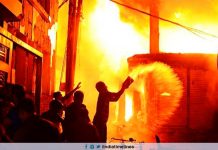
A devastating fire at a building in Kuwait has resulted in the tragic loss of 41 lives, with several of the victims being Indian nationals. This heartbreaking incident has not only affected the victims and their families but has also sent shockwaves through the international community. Understanding the gravity of the situation and the sequence of events leading to this tragedy is crucial in comprehending the full impact of the fire.
The Incident
The fire broke out in the early hours of June 10th, 2024, at a residential and commercial building located in a densely populated area of Kuwait City. The blaze spread rapidly through the structure, catching many occupants off guard. Initial reports indicated that the fire started on one of the lower floors, quickly engulfing the building and trapping residents inside.
Casualties and Injuries
Tragically, 41 people lost their lives in the fire. Among the deceased, a significant number were Indian nationals, reflecting the diverse population residing in Kuwait. Many others sustained injuries of varying degrees, with several in critical condition. The identification of victims has been a painstaking process, involving coordination between local authorities and the Indian embassy.
Eyewitness Accounts
Survivors and witnesses provided harrowing accounts of the fire. One resident, who managed to escape, described the chaos as smoke filled the corridors, making it nearly impossible to see. Another witness, a nearby shop owner, recalled hearing screams and seeing people desperately trying to escape through windows.
Emergency Response
The response from emergency services was swift, with firefighters arriving on the scene within minutes of the alarm being raised. Despite their rapid action, the intensity of the fire made rescue operations extremely challenging. Medical teams were on standby to treat the injured, who were rushed to nearby hospitals for urgent care.
Building Details
The building, a mix of residential apartments and commercial spaces, was relatively old and not equipped with modern fire safety systems. This lack of safety infrastructure likely contributed to the high casualty rate, as many residents were unable to evacuate in time.
Cause of the Fire
Initial investigations suggest that the fire may have been caused by an electrical fault, although this has yet to be confirmed. Experts are conducting thorough examinations to determine the exact cause, and a detailed report is expected in the coming weeks.
Government Response
Kuwaiti officials have expressed their condolences and promised a thorough investigation into the incident. The Indian government has also responded, coordinating with Kuwaiti authorities to assist with the identification and repatriation of the deceased Indian nationals. Indian External Affairs Minister, S. Jaishankar, stated that every effort would be made to support the families of the victims.
International Reactions
The incident has drawn international attention, with various countries extending their sympathies to the victims’ families. Messages of condolence have poured in from across the globe, highlighting the shared sense of grief and the need for improved safety measures worldwide.
Safety Regulations in Kuwait
Kuwait has fire safety regulations in place, but this tragic event has underscored the need for stricter enforcement and regular updates to safety standards. Recent changes aimed at improving building safety will likely be scrutinized and possibly revised in light of this disaster.
Previous Incidents
This is not the first time Kuwait has experienced such a tragedy. Similar incidents in the past have raised concerns about building safety and emergency preparedness. Comparing these past events with the current fire can provide insights into persistent issues and areas needing improvement.
Impact on the Indian Community
The Indian community in Kuwait, which is one of the largest expatriate groups, has been deeply affected by this incident. Community leaders and organizations have rallied to support the victims and their families, offering both emotional and logistical assistance.
Support for Victims
Support has been forthcoming from various quarters, including NGOs and community groups. Immediate aid has been provided to the injured and the families of those who perished. Efforts are also underway to raise funds and provide ongoing support as the victims and their families navigate this difficult time.
Preventive Measures
In the wake of the fire, there have been numerous calls for action to prevent such tragedies in the future. Recommendations include updating fire safety standards, ensuring regular inspections, and implementing advanced fire detection and suppression systems in older buildings.
Conclusion
The fire in Kuwait is a stark reminder of the importance of stringent safety regulations and preparedness. As the investigation continues and support for the victims’ families grows, it is crucial to learn from this tragedy to prevent future occurrences. The international community stands united in grief and determination to improve safety standards for all.
FAQs
1. What caused the fire in the Kuwait building? The exact cause of the fire is still under investigation, but initial reports suggest it may have been due to an electrical fault.
2. How many Indians were among the casualties? Several Indian nationals were among the 41 fatalities, although the exact number is still being confirmed.
3. What has been the response from the Indian government? The Indian government has been actively coordinating with Kuwaiti authorities to assist with the identification and repatriation of the deceased Indian nationals.
4. How are the victims’ families being supported? Various NGOs and community groups are providing immediate aid, including financial support and counseling, to the victims’ families.
5. What measures are being proposed to prevent future incidents? Recommendations include updating fire safety standards, conducting regular inspections, and installing advanced fire detection and suppression systems in older buildings.

































